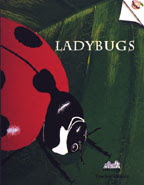We're studying insects this month. This week our focus has been on ladybugs. We've been learning so much about this amazing and helpful insect and wanted to share some of our adventures.
 |
| We've used the GEMS: Ladybugs guide during our study. GEMS guides are amazing and worth checking out. |
We began by asking what the kiddos already knew about ladybugs. We wrote down whatever they said, even if we knew it was inaccurate. The goal was to check their current knowledge. We can modify the statements if it is determined that we need to make changes or deletions as we gain new knowledge.
I made a trip to OSH and picked up a container of LIVE ladybugs. I put them out in a variety of viewers. This provided for the kiddos to get an up-close and personal look at the insects. Whenever possible, it's best and more effective to teach children through hands-on experience. We wanted to make sure they could truly experience the ladybugs through close observation and touching.
Several viewers were displayed in both the science area and the writing area along with the ladybug cards. Several friends were inspired to write the word.
Some chose to observe and then drew images of the ladybugs, pretty accurately, at that.
One lesson was about the symmetry that ladybugs have. They have the same number of dots on each side of their cover wings. We explored this idea by pre-folding a paper, having the kiddos paint on it, press it closed, then open it back up. The results showed a mirror image on the unpainted side, as well as the original image.
We played Ladybug Dice Matching. Some children could look at the dice and know how many dots there were, others touched to count them. We also later discussed that not all of the ladybug images were correct, as they weren't symmetrical.
I had found a fingerplay about ladybugs. I modified it to be able to do it with props. We've done it a few times, then I placed it out for the kiddos to do it themselves, if they chose to do so. If you aren't able to read the post-it notes, here they are:
Five little ladybugs climbing on some plants, eating the aphids, but not the ants.
The first one said, "Save some aphids for me!"
The second one said, "These are tasty as can be!"
The third one said, "Oh, they're almost gone."
The fourth one said, "Then it's time to move on."
The fifth one said, "Come on. Let's fly!"
So they opened their wings and they flew through the sky.
Several friends were inspired by our study to don ladybug apparel.
We had been learning about the anatomy of a ladybug: head, thorax, abdomen, six legs, antennae, flying wings, and cover wings. Each kiddo had the opportunity to express their new-found anatomy knowledge by assembling their own ladybug. We had also discussed the symmetry of the dots and encouraged them to show that on the ladybug's cover wings. This was not an art project, but a science lesson. Each child's ladybug was still uniquely different, but was a great opportunity to review what we had learned.
We did a drama about how the ladybug protects itself when birds swoop in for a snack and carried the drama outside. In the photo above, the ladybugs were busy crawling all around.
The above image shows the friend on the right swooping in as a bird. Some "ladybugs" flew away while others laid on their backs and got really still so the bird wouldn't see them. They also learned that sometimes the ladybugs emit a stinky liquid from their legs that deters their enemies.
After observing the ladybugs for two days, we trekked to the school's garden and released them. Some crawled around on hands for a bit, some crawled from the hands to plants, and some happily flew away.
We're learning so much...and keepin' it real.









.jpg)


















